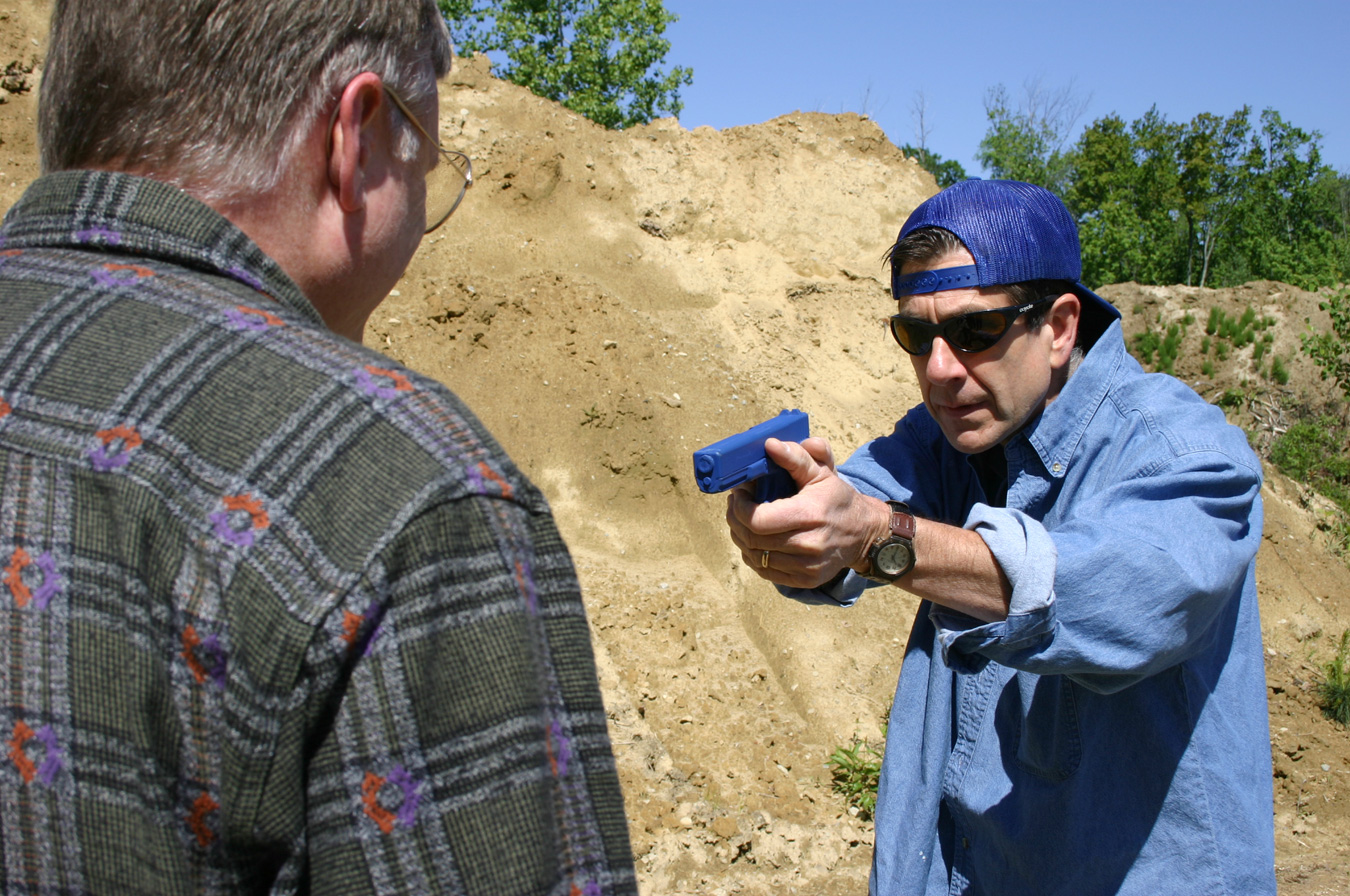In order to survive a threat, three primary elements need to work together. First and foremost, you need to become aware of the threat. You then need to assess the threat. And finally, you must decide upon and carry out the appropriate response.
Awareness
To be able to identify a threat, you must maintain a constant mental awareness. Without awareness, the best gun, the most powerful ammunition, and all of the tactical training in the world will be useless. If you are unaware of your surroundings, you are unprepared to react—a recipe for the perpetrator to prevail. A ‘surprise attack’ may not be a surprise if you are aware of your surroundings.

While walking from the store to your car, are you oblivious to your surroundings or alert to other pedestrians and cars? Did you see the person lurking behind the tree? Did you check your back seat before entering your car? Do you look at the interior mirrors before entering an elevator?
As with many other things, there are various levels of awareness that range from a complete lack of awareness of your surroundings and situation to knowing you are under direct attack. The U.S. military color codes are used to categorize and describe levels of awareness. It is useful to understand the levels, not only as a definition, but also as a guide to what levels of awareness are appropriate for different situations.
Awareness Color Codes
White – Unprepared for violence, not alert to symptoms or signs of violence. Going about your own business in an ignorant daze. Many car accidents happen because drivers are in condition white.
Yellow – Relaxed alertness. Not tense or nervous, but maintaining mental awareness of surroundings and possible intent of others. Alertness to surroundings would include such things as looking at your surroundings and noticing who is present as you walk down the street and knowing lanes of egress in every situation you find yourself in.
Orange – Perception of a threat, but of unknown nature. An example would be the sound of glass breaking that could indicate a burglar or a cat knocking something over. This heightened state of alert causes ‘Body Alarm Reaction’ which increases pulse rate, blood pressure, and breathing. Ready your weapons and take immediate note of concealment, cover, and lanes of egress.
Red – You perceive an immediate danger to you. With a direct threat, immediately take cover, draw your weapon, control the lane of egress, and use verbalization to engage and challenge the threat.
Black – This level corresponds to a direct lethal assault in progress, a non-negotiable situation. This action causes the need to neutralize the situation by shooting to stop the attacker.
Benefits of Awareness
Situational awareness encompasses several main elements: looking for potential attackers, knowing the locations of cover and concealment, finding exits and seeking lanes of egress.

Being aware of your situation and surroundings can benefit you threefold.
You can escape trouble by simply avoiding it. If you are watching your surroundings and you see what looks like trouble ahead, stay clear.
Knowing about trouble ahead of time can give you time to prepare a plan, seek out cover and concealment, and ready your weapons (retrieve pepper spray, open your knife, place hand on gun, etc.)
If the assailant knows you are aware of his presence and possibly prepared for an encounter, he may simply decide to find an easier victim.
Criminals most often don’t select a victim at random. They seek an opponent they can beat readily. They would rather take $10 from an easy victim than fight with a victim over $50. In the 1960s, street thugs would often seek out hippies to victimize, since they would surrender their valuables without a struggle, and would not report the crime to police. Today, little has changed. Criminals seek victims who are unaware and unprepared. They seek those living in condition ‘white.’ Natives of New York City call people who look up at the skyscrapers tourists, criminals call them victims.
All too many people exist in a state of ‘white.’ I also refer to this as ignorant bliss. It is best to be aware of your surroundings at all times, remain vigilant and alert. You can live your entire life in ‘yellow’ without any psychological harm whatsoever.
Condition yellow tells the criminal who is stalking you that you are aware of your surroundings and probably aware of his presence. The assailant will get a sense that you are not the easy victim he seeks.
Being alert does not mean you are paranoid. Wherever you are, be aware of others. Look for indications of their intentions. Are they simply walking to their car, or are they looking inside every car they pass?
Widen your vision. Don’t concentrate on just what is in front of you, but also what surrounds you. Note possible concealment and cover. If someone were to burst out shooting right this instant, what would you do? Where would you hide? How would you escape? What would you do to stop the attack?
Threat Assessment
Before you can determine your response to a perceived threat, you must understand the level of jeopardy facing you. Threat assessment can be the most difficult survival element, both because the attacker may mask his true intentions and the severity of the potential harm may not yet be evident.
An assailant might threaten you with grave bodily harm but point a water pistol. A mugger may say that you will not be hurt if you hand over your wallet, but stab you as you reach to give it to him.

As difficult as it may be to determine, your response needs to be appropriate to the perceived threat level. If you overreact, you could land in jail. If you don’t react, or under-react, you could land six feet under. Start your assessment by determining whether the danger is a direct threat to you. Your response will differ significantly depending on the circumstances.
If threatened directly with gunfire, take cover, draw your weapon, and return fire if appropriate. If you hear a random gunshot and are not in direct danger, take cover, then get out of the area (quickly), as soon as you are sure it is safe. Keep in mind that to draw a weapon in this situation may put you in mortal danger. A police officer or concerned citizen may see you with a drawn gun and assume that you are the criminal. Remember, the purpose of the firearm is to get you out of trouble, not into it.
Presuming you are faced with a direct threat, is it a lethal threat? Does the perpetrator want to simply punch you, or beat you with a baseball bat? In order to respond with lethal force, you must be facing an imminent threat of death or grave bodily harm. You generally cannot use more force than you are threatened with.
Does the perpetrator have the ability to carry out the threat? Is the threat imminent? Are you being threatened with a knife from across a wide street, or is the attacker just 20 feet away and closing? A knife threat from 50 feet is not a lethal threat, while the same threat with a gun could be considered lethal. If you are being threatened with a gun, is the gun being drawn? Is the threat less immediate because the perpetrator does not have the gun in his hand?
Are you just being verbally threatened, or is the attack in progress? If you are threatened as intimidation, you do not have the right to use lethal force because you are not in immediate jeopardy of losing your life or suffering grave bodily harm.
Elements of Response
Most shooters I have come in contact with are far more concerned about the choice of gun, caliber, and cartridge than tactics. In reality, the type of gun and ammunition are almost unimportant. How you use what you have is far more important.
The elements of response in order of importance are:
- Proper tactics
- Skill with defensive weapon
- The choice of weapon
The order of importance is very telling. Tactics (what you do) are more important than how you do it and what you do it with. Tactics means being aware of your situation and surroundings, knowing what skills to apply and how to apply them. Tactics means understanding such things as knowing where you are in relation to cover, and how to get to the closest door. It means understanding how to traverse a doorway, and how to flank your opponent. The ability to hit the 10 ring of a paper target is unimportant, if you are dead before you can pull your gun out.
Tactics also includes avoiding a situation when you perceive a threat. If you see a threat on the sidewalk ahead of you, why not just cross the road and place yourself out of the person’s reach? It is far better to avoid trouble than to deal with it after it starts.
Once you have applied the proper tactics, skill in the use of your chosen weapon (shooting, in the case of a firearm) is the next most important element. While I dislike repeating clichés, these are appropriate:
“A hit with a 9mm is better than a miss with a .45.”
“A slow hit is better than a fast miss.”
Simply stated, shot placement is far more important than what bullet you are shooting or gun you are shooting.
What is lost on many people is that the choice of gun and ammunition is actually the least important element of survival. The smallest gun in the hands of an aware, prepared, and skilled person is much more effective than the largest gun in the hands of a person who is unprepared to present a proper defense. The number one element of survival is awareness. Once an attack has commenced, proper use of tactics will give you an opportunity to survive. A series of well-placed rounds should stop the attack.
How do you remain situationally aware? Share your answer in the comment section.
David Kenik is the owner of Armed Response, author of the book, Armed Response, and co-author of the Armed Response Video Training Series. www.armedresponsetraining.com
Sign up for K-Var’s weekly newsletter and discounts here.

Leave a Reply